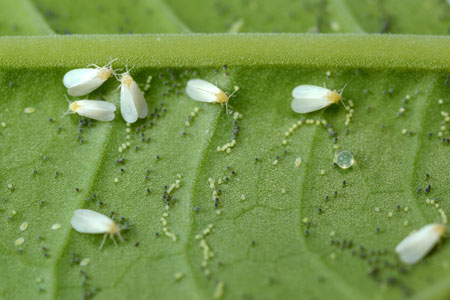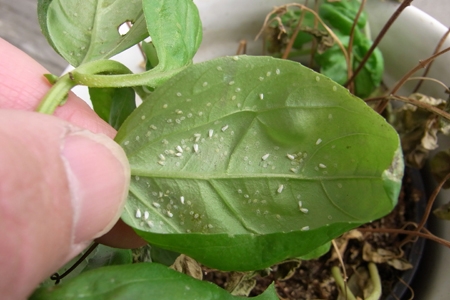Home » Bugs » Lawn Pests »
Active Seasons



Whitefly Appearance and Size Facts
Whiteflies are winged insects that bear a closer resemblance to moths than typical flies. To make things even more confusing, whiteflies are actually “true bugs”, with their mouthparts built to pierce plant tissues and suck out the nutrients. They possess distinctive characteristics, such as the powdery wax that covers their bodies and serves as a protective layer. These pests, measuring around 1/16 of an inch in length, cause harm by tapping into plant phloem to extract sugar-rich juices. They tend to gather in significant numbers and swiftly overpower plants, meaning fast-acting pest control is essential.
Distinguishing Whiteflies From Other Insects
The powdery wax covering their bodies is the key identifier in differentiating whiteflies from other insects. This characteristic is unique to them, so if you encounter small, powdery-winged insects on plant leaves, especially on the underside, they’re likely whiteflies. Because whiteflies can be difficult to identify, a professional pest control company is often needed to make the correct identification.
We provide whitefly treatment in the following locations and their surrounding areas:

Behavior and Habitat of Whiteflies
Whiteflies inflict plant damage by tapping into the phloem, which is the channel plants use to transfer nutrients. This is how the whiteflies extract carbohydrate-rich plant juices. The resulting sap loss and plant reactions to whitefly saliva contribute to plant deterioration. As whiteflies gather in substantial numbers, they can quickly overpower plants. Their excretion of honeydew further poses a challenge by promoting sooty mold growth and compromising crops with its sticky residue.
Whiteflies predominantly inhabit the undersides of plant leaves, targeting a wide range of hosts within landscapes. Ornamental plants are particularly susceptible to silverleaf whitefly infestations, highlighting the need for proactive pest management.

Signs of Infestation of Whiteflies
Individual whiteflies may be hard to spot, but the destruction they cause is not. Look for leaf damage, sap drainage, honeydew secretion attracting other insects, sometimes associated with sooty mold growth, and overall unsightly plant appearances. If you notice these signs, it’s time to call Hulett.

Tips for Prevention of Whiteflies
Effectively preventing a whitefly infestation can be challenging, with the only sure solution being professional intervention. Planting the correct plants in the correct area according to their shade and water requirements, as well as proper pruning and trimming practices can help keep a plant healthy, giving it the best chance to fight off whitefly infestation. However, in South Florida, professional pest control is often still needed. Hulett Environmental Services offers the best strategy to manage this persistent pest. Our expertise ensures tailored solutions for efficient whitefly control, protecting your plants and mitigating potential damage.
Getting Rid of Whiteflies
Addressing a whitefly infestation requires professional expertise. Only a trained pest control team can effectively remove these pests while maintaining a healthy environment for you, your landscape, and your whole family. Hulett Environmental Services offers comprehensive pest control services to assess, manage, and eliminate whiteflies so your plants can thrive again.
Effective Whitefly Control Solutions
Count on Hulett Environmental Services for reliable whitefly control. Contact us for a free inspection and personalized pest control solutions tailored to your unique situation so your plants can flourish. Schedule your inspection online today!


